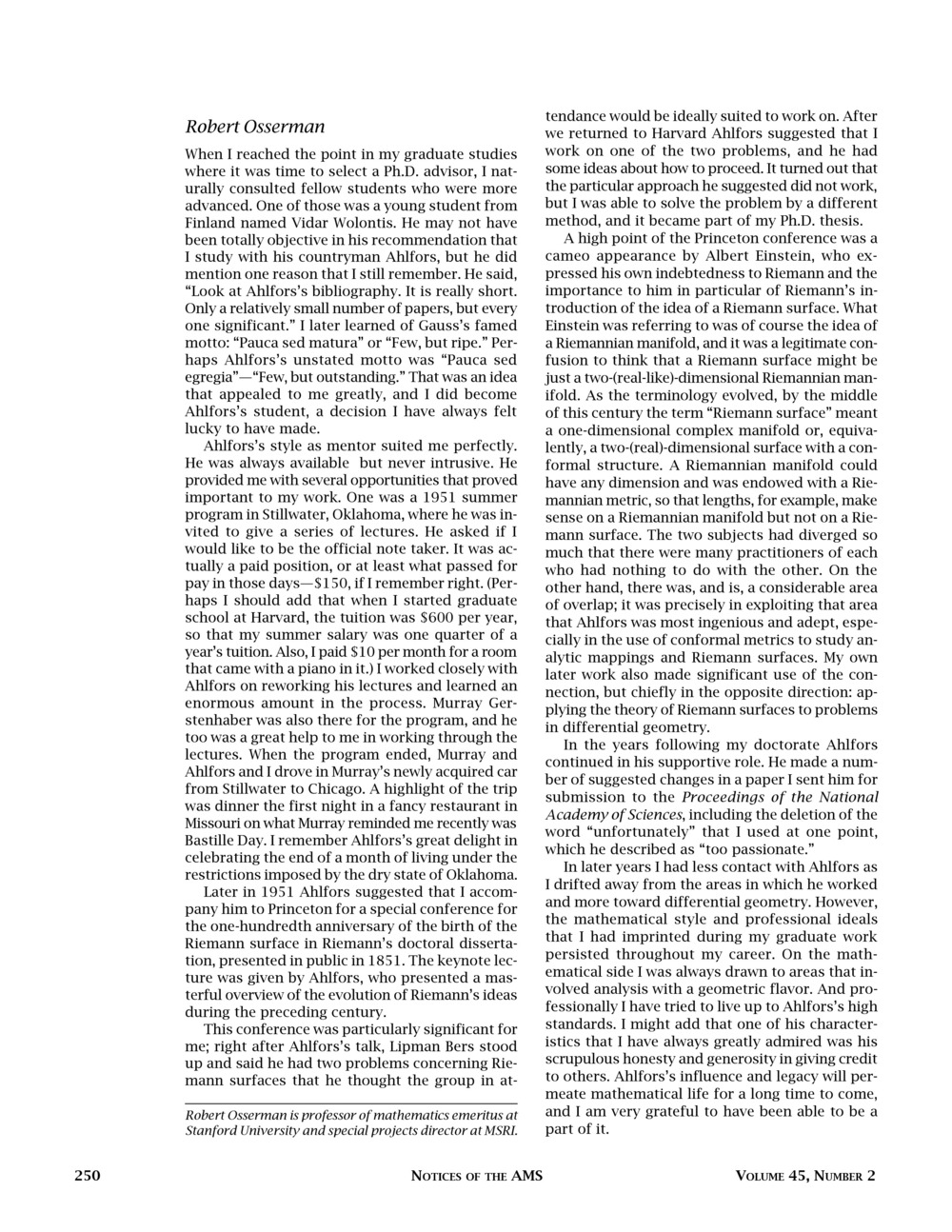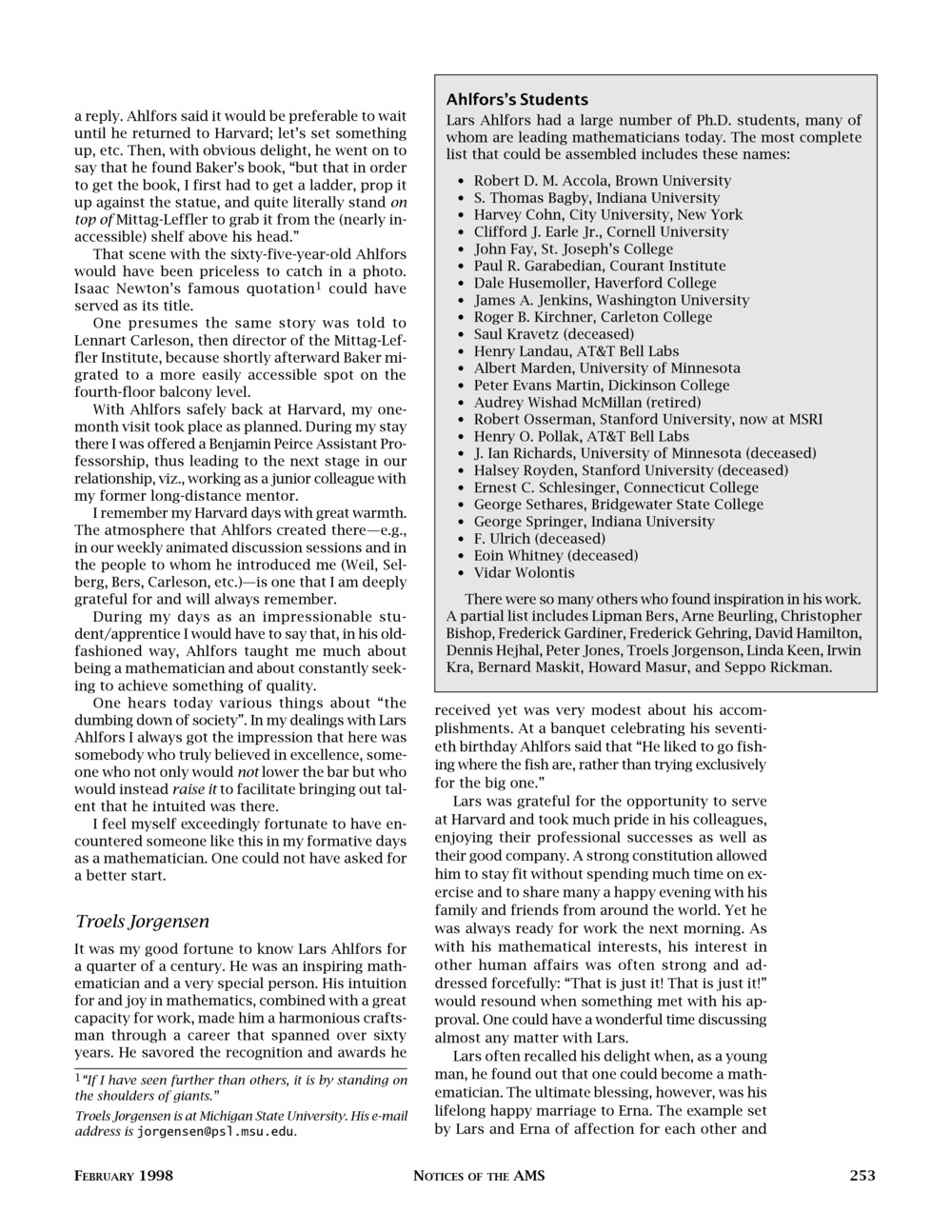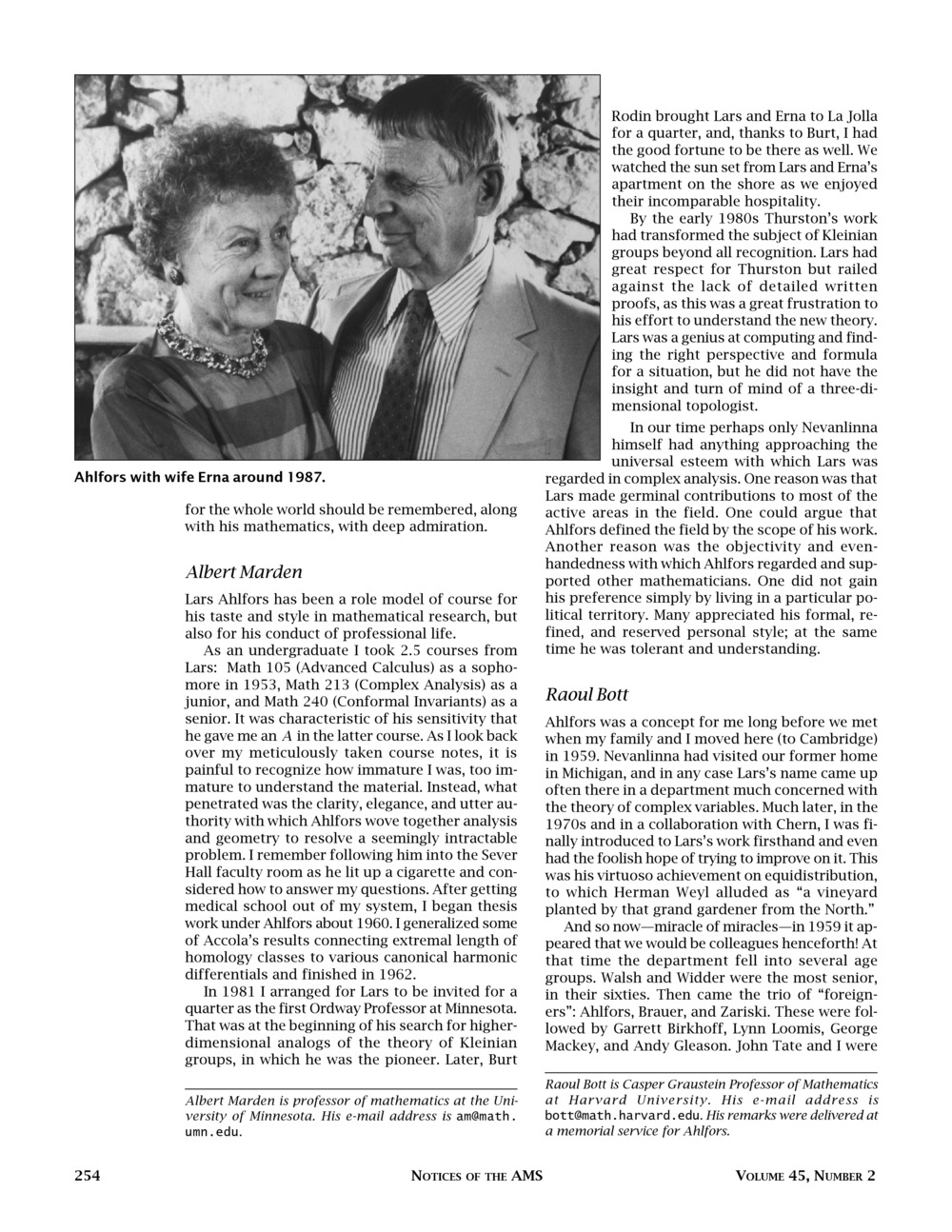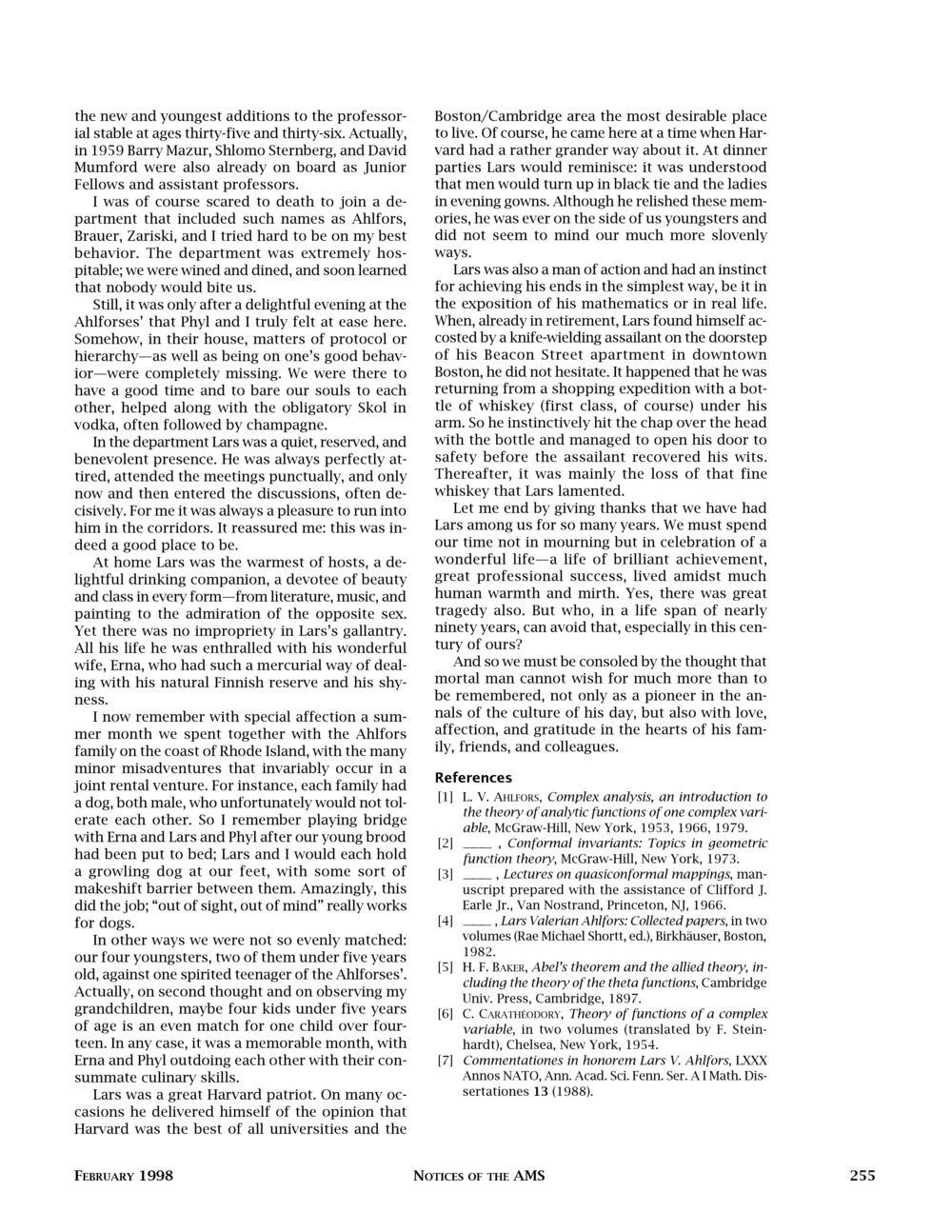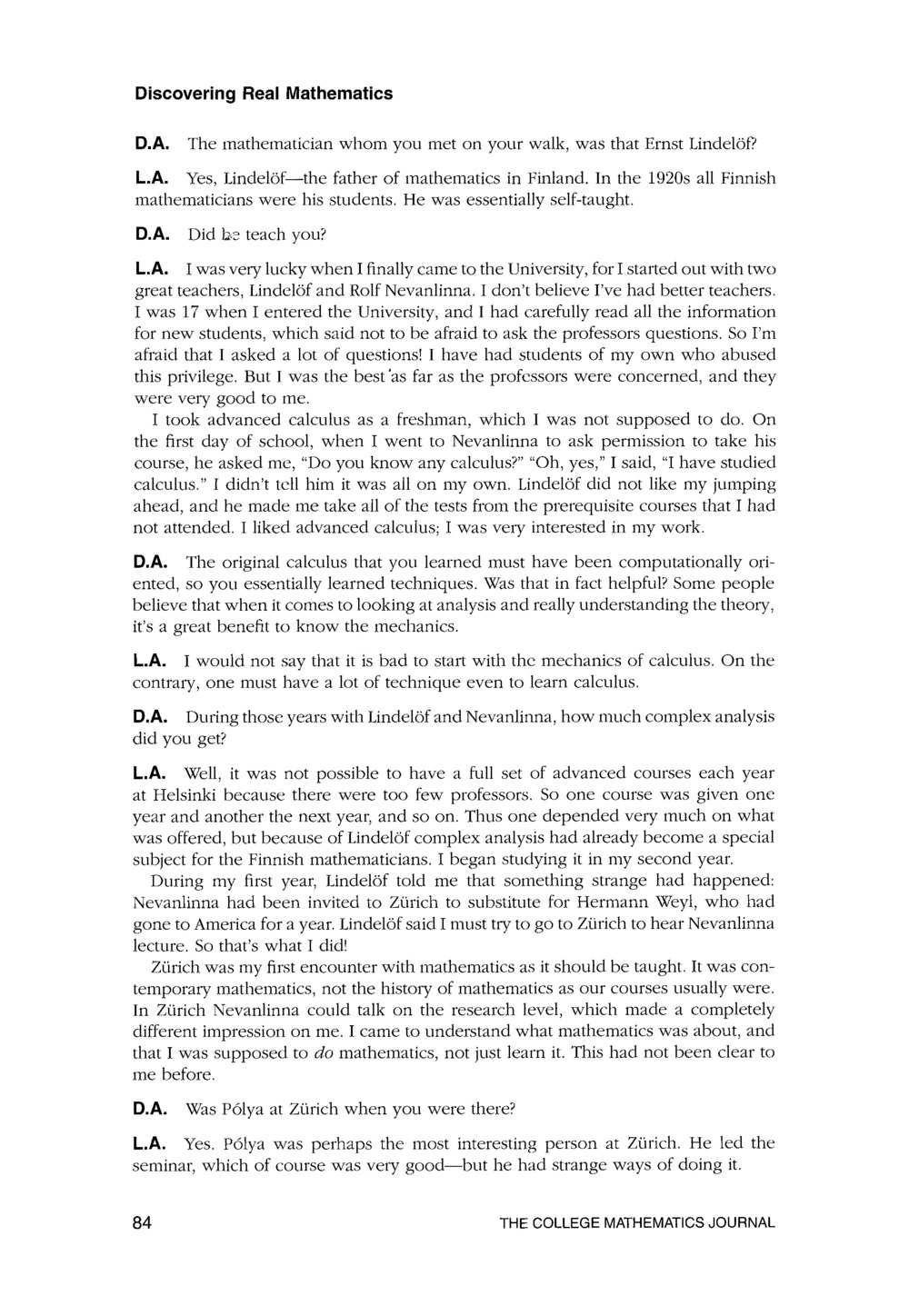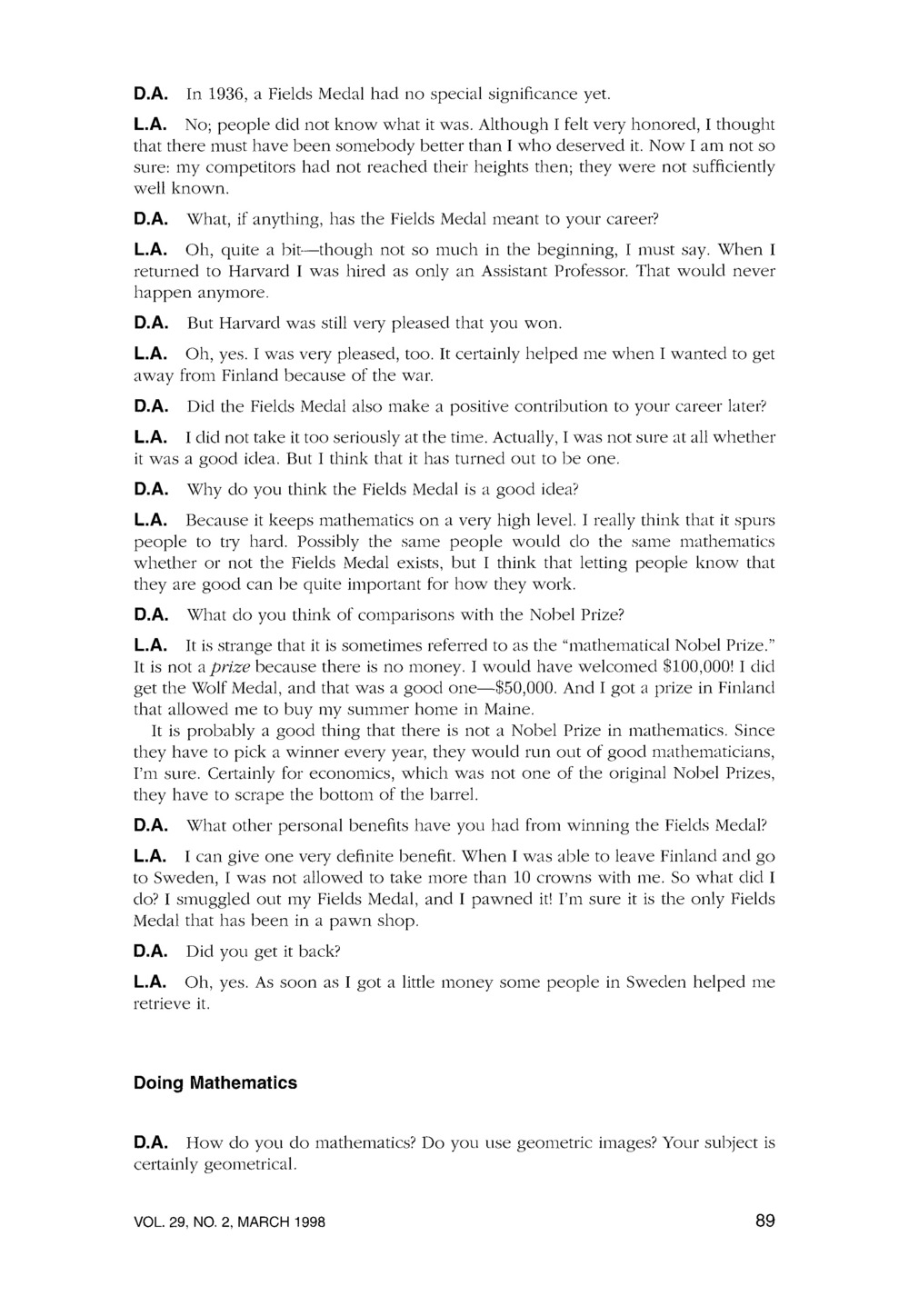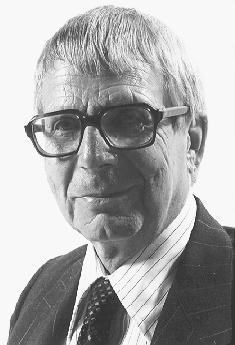 Lars Valerian Ahlfors, William Caspar Graustein Professor of Mathematics,
died of pneumonia on Oct. 11 in Pittsfield, Mass., at the age of 89.
Ahlfors won the first Fields Medal awarded by the International
Mathematics Society in 1936, a quadrennial award considered equivalent, in
mathematics, to the Nobel Prize. In 1979, he was awarded the prestigious
Wolf Prize in Jerusalem.
Ahlfors was best known for his work in complex analysis, a fundamental
subject with many applications from number theory to modern physics.
His textbook, Complex Analysis, first published in 1953, with new editions
in 1966 and 1979, is still considered the leading text in the field. He
wrote three other mathematical books and published almost 100 papers.
Colleagues and students have described his work as extraordinarily
elegant, and his lectures, delivered in thundering basso, as stunningly
beautiful.
Ahlfors was born in Helsinki, Finland, in 1907. As he often observed,
his mother's death during his birth critically influenced his life. His
father, a professor of mechanical engineering at the Polytechnic
Institute, was attentive but stern.
In the brief autobiographical note that introduced his collected papers,
published in 1982, he wrote that, "As a child, I was fascinated by
mathematics without understanding what it was about, but I was by no means
a child prodigy. As a matter of fact, I had no access to any mathematical
literature except in the highest grades. . . . The high school curriculum
did not include any calculus but I finally managed to learn some on my
own, thanks to clandestine visits to my father's engineering library."
Ahlfors' introduction to higher mathematics, including complex analysis,
came from his mentors at Helsinki University, Ernst Lindelof and
Rolf Nevanlinna. At 21, Ahlfors followed Nevanlinna to the Federal
Polytechnic Institute in Zurich, where he began working at a research
level. There he produced his first major work, a study of asymptotic
values of an entire function, based on his own new approach to conformal
mapping. Self-effacingly, Ahlfors credited Nevanlinna and another
teacher, George Polya, for their "considerable help." They, in turn,
insisted that he publish the results solely in his own name.
Thereafter, as he expressed it, "I have tried to repay my debt by never
accepting to appear as coauthor with a student."
In 1933, he returned to Helsinki, where he met and married Erna Lehnert,
an event he described as the "happiest and most important in my life."
In 1935, he began a three-year stint teaching at Harvard. Homesick,
he returned to Finland in 1938. There he spent most of the war years
as professor at the University of Helsinki before being invited back to
Zurich in 1944.
Ahlfors returned to Harvard, as full professor, in 1946 and remained
until his retirement in 1977. From 1964, he occupied the William Caspar
Graustein chair.
Ahlfors won several honorary doctorates, including one from the University
of London and one from Harvard.
As is typical in mathematics, Ahlfors achieved renown from work done while
in his twenties. Less typically, he continued for decades to produce
highly influential work, notably his proof of the "Ahlfors finiteness
theorem," published in 1964.
Ahlfors is survived by his wife, Erna, who lives in Nassau, N.Y.;
three daughters, Cynthia Edwards of Jumeauville, France, Vanessa Gruen
of Darien, Conn., and Old Chatham, N.Y., and Caroline Mouris of Nassau,
N.Y.; a brother, Axel Ahlfors of Torup, Sweden; a sister, Unga Appelqvist
of Helsinki; grandchildren and great-grandchildren.
Source: Harvard Gazette 1996.
Lars Valerian Ahlfors, William Caspar Graustein Professor of Mathematics,
died of pneumonia on Oct. 11 in Pittsfield, Mass., at the age of 89.
Ahlfors won the first Fields Medal awarded by the International
Mathematics Society in 1936, a quadrennial award considered equivalent, in
mathematics, to the Nobel Prize. In 1979, he was awarded the prestigious
Wolf Prize in Jerusalem.
Ahlfors was best known for his work in complex analysis, a fundamental
subject with many applications from number theory to modern physics.
His textbook, Complex Analysis, first published in 1953, with new editions
in 1966 and 1979, is still considered the leading text in the field. He
wrote three other mathematical books and published almost 100 papers.
Colleagues and students have described his work as extraordinarily
elegant, and his lectures, delivered in thundering basso, as stunningly
beautiful.
Ahlfors was born in Helsinki, Finland, in 1907. As he often observed,
his mother's death during his birth critically influenced his life. His
father, a professor of mechanical engineering at the Polytechnic
Institute, was attentive but stern.
In the brief autobiographical note that introduced his collected papers,
published in 1982, he wrote that, "As a child, I was fascinated by
mathematics without understanding what it was about, but I was by no means
a child prodigy. As a matter of fact, I had no access to any mathematical
literature except in the highest grades. . . . The high school curriculum
did not include any calculus but I finally managed to learn some on my
own, thanks to clandestine visits to my father's engineering library."
Ahlfors' introduction to higher mathematics, including complex analysis,
came from his mentors at Helsinki University, Ernst Lindelof and
Rolf Nevanlinna. At 21, Ahlfors followed Nevanlinna to the Federal
Polytechnic Institute in Zurich, where he began working at a research
level. There he produced his first major work, a study of asymptotic
values of an entire function, based on his own new approach to conformal
mapping. Self-effacingly, Ahlfors credited Nevanlinna and another
teacher, George Polya, for their "considerable help." They, in turn,
insisted that he publish the results solely in his own name.
Thereafter, as he expressed it, "I have tried to repay my debt by never
accepting to appear as coauthor with a student."
In 1933, he returned to Helsinki, where he met and married Erna Lehnert,
an event he described as the "happiest and most important in my life."
In 1935, he began a three-year stint teaching at Harvard. Homesick,
he returned to Finland in 1938. There he spent most of the war years
as professor at the University of Helsinki before being invited back to
Zurich in 1944.
Ahlfors returned to Harvard, as full professor, in 1946 and remained
until his retirement in 1977. From 1964, he occupied the William Caspar
Graustein chair.
Ahlfors won several honorary doctorates, including one from the University
of London and one from Harvard.
As is typical in mathematics, Ahlfors achieved renown from work done while
in his twenties. Less typically, he continued for decades to produce
highly influential work, notably his proof of the "Ahlfors finiteness
theorem," published in 1964.
Ahlfors is survived by his wife, Erna, who lives in Nassau, N.Y.;
three daughters, Cynthia Edwards of Jumeauville, France, Vanessa Gruen
of Darien, Conn., and Old Chatham, N.Y., and Caroline Mouris of Nassau,
N.Y.; a brother, Axel Ahlfors of Torup, Sweden; a sister, Unga Appelqvist
of Helsinki; grandchildren and great-grandchildren.
Source: Harvard Gazette 1996.
|
 Lars Valerian Ahlfors, William Caspar Graustein Professor of Mathematics,
died of pneumonia on Oct. 11 in Pittsfield, Mass., at the age of 89.
Ahlfors won the first Fields Medal awarded by the International
Mathematics Society in 1936, a quadrennial award considered equivalent, in
mathematics, to the Nobel Prize. In 1979, he was awarded the prestigious
Wolf Prize in Jerusalem.
Ahlfors was best known for his work in complex analysis, a fundamental
subject with many applications from number theory to modern physics.
His textbook, Complex Analysis, first published in 1953, with new editions
in 1966 and 1979, is still considered the leading text in the field. He
wrote three other mathematical books and published almost 100 papers.
Colleagues and students have described his work as extraordinarily
elegant, and his lectures, delivered in thundering basso, as stunningly
beautiful.
Ahlfors was born in Helsinki, Finland, in 1907. As he often observed,
his mother's death during his birth critically influenced his life. His
father, a professor of mechanical engineering at the Polytechnic
Institute, was attentive but stern.
In the brief autobiographical note that introduced his collected papers,
published in 1982, he wrote that, "As a child, I was fascinated by
mathematics without understanding what it was about, but I was by no means
a child prodigy. As a matter of fact, I had no access to any mathematical
literature except in the highest grades. . . . The high school curriculum
did not include any calculus but I finally managed to learn some on my
own, thanks to clandestine visits to my father's engineering library."
Ahlfors' introduction to higher mathematics, including complex analysis,
came from his mentors at Helsinki University, Ernst Lindelof and
Rolf Nevanlinna. At 21, Ahlfors followed Nevanlinna to the Federal
Polytechnic Institute in Zurich, where he began working at a research
level. There he produced his first major work, a study of asymptotic
values of an entire function, based on his own new approach to conformal
mapping. Self-effacingly, Ahlfors credited Nevanlinna and another
teacher, George Polya, for their "considerable help." They, in turn,
insisted that he publish the results solely in his own name.
Thereafter, as he expressed it, "I have tried to repay my debt by never
accepting to appear as coauthor with a student."
In 1933, he returned to Helsinki, where he met and married Erna Lehnert,
an event he described as the "happiest and most important in my life."
In 1935, he began a three-year stint teaching at Harvard. Homesick,
he returned to Finland in 1938. There he spent most of the war years
as professor at the University of Helsinki before being invited back to
Zurich in 1944.
Ahlfors returned to Harvard, as full professor, in 1946 and remained
until his retirement in 1977. From 1964, he occupied the William Caspar
Graustein chair.
Ahlfors won several honorary doctorates, including one from the University
of London and one from Harvard.
As is typical in mathematics, Ahlfors achieved renown from work done while
in his twenties. Less typically, he continued for decades to produce
highly influential work, notably his proof of the "Ahlfors finiteness
theorem," published in 1964.
Ahlfors is survived by his wife, Erna, who lives in Nassau, N.Y.;
three daughters, Cynthia Edwards of Jumeauville, France, Vanessa Gruen
of Darien, Conn., and Old Chatham, N.Y., and Caroline Mouris of Nassau,
N.Y.; a brother, Axel Ahlfors of Torup, Sweden; a sister, Unga Appelqvist
of Helsinki; grandchildren and great-grandchildren.
Source: Harvard Gazette 1996.
Lars Valerian Ahlfors, William Caspar Graustein Professor of Mathematics,
died of pneumonia on Oct. 11 in Pittsfield, Mass., at the age of 89.
Ahlfors won the first Fields Medal awarded by the International
Mathematics Society in 1936, a quadrennial award considered equivalent, in
mathematics, to the Nobel Prize. In 1979, he was awarded the prestigious
Wolf Prize in Jerusalem.
Ahlfors was best known for his work in complex analysis, a fundamental
subject with many applications from number theory to modern physics.
His textbook, Complex Analysis, first published in 1953, with new editions
in 1966 and 1979, is still considered the leading text in the field. He
wrote three other mathematical books and published almost 100 papers.
Colleagues and students have described his work as extraordinarily
elegant, and his lectures, delivered in thundering basso, as stunningly
beautiful.
Ahlfors was born in Helsinki, Finland, in 1907. As he often observed,
his mother's death during his birth critically influenced his life. His
father, a professor of mechanical engineering at the Polytechnic
Institute, was attentive but stern.
In the brief autobiographical note that introduced his collected papers,
published in 1982, he wrote that, "As a child, I was fascinated by
mathematics without understanding what it was about, but I was by no means
a child prodigy. As a matter of fact, I had no access to any mathematical
literature except in the highest grades. . . . The high school curriculum
did not include any calculus but I finally managed to learn some on my
own, thanks to clandestine visits to my father's engineering library."
Ahlfors' introduction to higher mathematics, including complex analysis,
came from his mentors at Helsinki University, Ernst Lindelof and
Rolf Nevanlinna. At 21, Ahlfors followed Nevanlinna to the Federal
Polytechnic Institute in Zurich, where he began working at a research
level. There he produced his first major work, a study of asymptotic
values of an entire function, based on his own new approach to conformal
mapping. Self-effacingly, Ahlfors credited Nevanlinna and another
teacher, George Polya, for their "considerable help." They, in turn,
insisted that he publish the results solely in his own name.
Thereafter, as he expressed it, "I have tried to repay my debt by never
accepting to appear as coauthor with a student."
In 1933, he returned to Helsinki, where he met and married Erna Lehnert,
an event he described as the "happiest and most important in my life."
In 1935, he began a three-year stint teaching at Harvard. Homesick,
he returned to Finland in 1938. There he spent most of the war years
as professor at the University of Helsinki before being invited back to
Zurich in 1944.
Ahlfors returned to Harvard, as full professor, in 1946 and remained
until his retirement in 1977. From 1964, he occupied the William Caspar
Graustein chair.
Ahlfors won several honorary doctorates, including one from the University
of London and one from Harvard.
As is typical in mathematics, Ahlfors achieved renown from work done while
in his twenties. Less typically, he continued for decades to produce
highly influential work, notably his proof of the "Ahlfors finiteness
theorem," published in 1964.
Ahlfors is survived by his wife, Erna, who lives in Nassau, N.Y.;
three daughters, Cynthia Edwards of Jumeauville, France, Vanessa Gruen
of Darien, Conn., and Old Chatham, N.Y., and Caroline Mouris of Nassau,
N.Y.; a brother, Axel Ahlfors of Torup, Sweden; a sister, Unga Appelqvist
of Helsinki; grandchildren and great-grandchildren.
Source: Harvard Gazette 1996.


